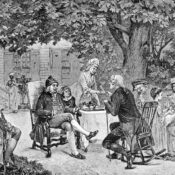In the early 1900s, it was uncommon for women to work outside the home. It was even rarer for a married woman to do so. Even more unlikely was a woman with a law degree. And for that woman to solve murders and robberies, become the first special assistant U.S. attorney, and then a detective for the NYPD? Unheard of.
Yet, that’s exactly what Mrs. Mary Grace Quackenbos did.
Mary Grace Quackenbos believed in common sense, not luck, and certainly not what many people called “women’s intuition.” Even so, she had the good luck to be born into a family with money, raised in New York City, and graduate from Hunter College in 1888. Born Mary Grace Winterton, she acquired her unusual last name when she married Dr. Henry Quackenbos in 1895. The marriage didn’t last, ending in divorce at a time when getting a divorce wasn’t easy – and often not good for a woman’s reputation. But Mary Grace Quackenbos didn’t care. She moved forward with her life, starting with law school.
On June 4, 1903, the 110 graduates of NYU’s law school lined up to receive their Bachelor of Laws degrees. Coed since 1890, the NYU School of Law graduates included about 11 women. Quackenbos was one of them. Common sense had led her to law school in the first place: She knew she would inherit a sizable estate, and she wanted to make sure she could protect that inheritance. What Quackenbos didn’t expect, perhaps, is that she would fall in love with the law. In the years that followed, she became an important legal advocate for women and immigrants. Mary Grace Quackenbos — later Humiston — embodied the life of Progressive era reform, using her education and means to help others.
After her NYU graduation, Quackenbos spent a year at the Legal Aid Society before sitting for the bar in 1904. The Legal Aid Society had been operating in New York for almost two decades, providing legal support to those who could not afford it. They began by helping immigrants, but by the time Quackenbos joined, their goal was to help anyone who needed them.
By late 1905, Quackenbos had opened her own law firm, which was similar in concept to the Legal Aid Society. The People’s Law Firm, she explained, would help all people, regardless of their ability to pay. Her career was taking off, especially after she successfully apprehended two thieves who had eluded the police. Ten days after reporting a robbery, the Spanish legation secretary saw that the police were no closer to solving the crime. He visited Quackenbos, who pursued the crime quickly. Within a month, she had delivered both robbers into police hands, confessions and all. Quackenbos played both detective and lawyer to help her client, a strategy that would become common for her. It was her listening skills, her tenacity, and her willingness to brave danger that helped Quackenbos.
In January 1906, Quackenbos saved an Italian immigrant woman from the death penalty. Quakenbos intervened just days before Antoinette Tolla’s scheduled execution, bringing important evidence to light. Quackenbos helped prove that while Tolla had killed a man, key evidence had been withheld — namely, that Tolla acted in self-defense. Tolla served about six years in prison before being released in 1912. Outlining the details of the case, the Evening World praised Quackenbos, “for she accomplished what her more experienced colleagues feared even to undertake.”

Much of Quackenbos’s early work focused on helping immigrants. Just months after the Tolla case ended, Quackenbos learned about a scheme affecting local immigrants and their families. A number of New York City men had responded to advertisements promising jobs in Florida. The pay was $1.25 per day (about $35 in today’s money), and the ads said the men would receive free transportation to Florida. They hoped to send money back to their families, but neither the money nor word from the men arrived. Finally, one man returned; Joseph Wilensky was now a man whose body had been broken and bore whip scars across his back. The men had become trapped in peonage. Their employers claimed the men owed them money for food, lodging, and other expenses. Day by day, the men’s wages were never enough to wipe out the debt they owed. As the men continued to work, their so-called debts grew, creating a vicious cycle. The men were forced to keep working, which kept them in debt.
Quackenbos traveled to Florida on behalf of these men. She began investigating peonage and discovered it was being used all over the South. Immigrants and people of color were those most likely to be caught in the system. Her documentation and reports caught the eye of the United States government and, in the months that followed, the Department of Justice named her a United States attorney. No woman had ever held such a role.
Throughout 1906 and 1907, Quackenbos investigated potential sites of peonage across the South, particularly focusing on cases affecting immigrants. Quackenbos had the support of the Department of Justice and the Italian ambassador to the United States, who was very concerned about reports that Italians were being enticed to come to the United States for work, only to end up in peonage. Working undercover at first, Quackenbos investigated Sunnyside Plantation in Arkansas. She determined that Sunnyside’s owners were violating immigration and labor laws. But the men she investigated did not like being targeted — particularly by a woman. One owner of Sunnyside was charged with peonage, but another owner, lawyer LeRoy Percy, complained about Quackenbos to his old friend and hunting buddy, President Theodore Roosevelt.
President Roosevelt had a reputation for Progressive reform himself. He supported conservation efforts and worked to eliminate business trusts that he thought were bad for Americans. But a woman lawyer investigating his old friend was another matter. Quackenbos was sent back to Washington and the Department of Justice shoved her reports in a drawer. Quackenbos had once believed that “With proper support…I can completely wipe out peonage in the south within the next year.” That goal remained only a dream, but Quackenbos never lost her determination and common sense.
In 1911, Quackenbos remarried, replacing her first married name with the much less-lively “Humiston.” But in 1917, she gained yet another name: The newspapers dubbed her “Mrs. Sherlock Holmes” when she solved the murder of 18-year-old Ruth Cruger, yet another case that had appeared to baffle the police. For her success, Humiston was offered a detective position with the New York Police Department and went to work on cases involving young missing women.

Mary Grace Quackenbos Humiston mostly fell out of the news after 1917. Her determination, however, continued to catch the public eye. Following the Cruger case, she turned her attention to rumors of prostitution rings at a U.S. military camp. When she couldn’t provide hard evidence, the secretary of war disavowed her, perhaps worried that she would ruin the reputation of the nation’s fighting men.
But when she died in 1948, her obituary highlighted that she had pursued justice and equality through her career and her life. It noted her long record of finding justice for those wrongfully accused, protecting young women, and supporting individuals who had been sent to mental institutions wrongly. She had also worked for equal rights for women in the legal field. At the time of her death, she was hailed no longer as a “lady lawyer” but a “crime lawyer,” one who had lived a life of trying to help others until the very end.
Become a Saturday Evening Post member and enjoy unlimited access. Subscribe now




Comments
This woman is so remarkable, I don’t know where to start. Thank you for this special report, Tanya. I think Mary Grace herself would be very pleased as well.